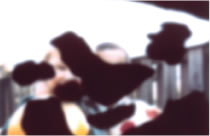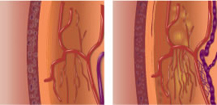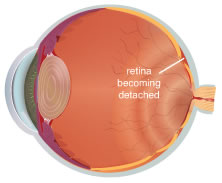

Diabetic Retinopathy
Diabetes is a condition that can affect the eye in a number of ways, people with diabetes are at a higher risk of cataracts and glaucoma, especially if they are aged 40 or over. The most serious condition associated with diabetes is diabetic retinopathy.
What is diabetic retinopathy?
Diabetic retinopathy occurs when some of the capillaries located at the back of the eye (the retina) become blocked and leaky, with time they will become fragile and tend to hemorrhage.
There are 3 main stages of diabetic retinopathy which are graded by how serious the condition is.
Stage 1 - Background diabetic retinopathy.
In the first stage blood vessels in the retina are only very mildly affected, they may bulge slightly, leak blood or fluid but your vision will probably remain normal with no threat to your sight.
Stage 2 - Maculopathy
Over time if the background diabetic retinopathy becomes more severe, this leads to maculopathy which means the macula (an important area in the middle of the retina which controls central vision) is now affected. The main symptom at this stage is a gradual loss of central vision, although your peripheral vision (side vision) will be preserved.
Stage 3 - Proliferative diabetic retinopathy
As the eye condition progresses this can sometimes lead to blood vessels in the retina becoming blocked. The eye tries to repair itself by forming new blood vessels, although these vessels are weak and can easily bleed, causing scar tissue to form and can ultimately lead to retinal detachment. If bleeding and retinal detachment occurs this may cause a sudden and severe loss of vision. If untreated total loss of vision could occur with proliferative diabetic retinopathy.
How can it be treated?
Early treatment for diabetic retinopathy cannot be stressed enough, it is recommended that you have an eye test every year so that your optician can monitor any changes that might occur due to diabetes. You should not to wait until your vision has deteriorated before you have an eye test.
If carried out early enough, laser treatment is often effective in preventing further sight loss for most sight threatening diabetic problems. However, treatment aims to preserve existing sight - it will not make it better. Good control of diabetes may help slow the onset and progression of retinopathy.
What happens during treatment?
Normally treatment is carried out at an outpatient clinic and you will not usually stay in hospital. Your pupils will be enlarged using eye drops so that the eye specialist can examine inside your eye. Your eye is then numbed with more drops and a small contact lens is fitted to stop you from blinking. You will be asked to move your eye in various directions during treatment, although this is easily done with the contact lens in place.
Will the laser treatment be painful?
The treatment for sealing blood vessels in the eye does not normally cause discomfort, however the treatment to remove new blood vessels can be a bit uncomfortable. You may need to take a pain-relieving tablet as well as the eye drops. Don’t be afraid to tell the eye specialist if the treatment is hurting, or if you have found a previous session of laser treatment distressing, as there is further pain relief available.
Will there be any side effects?
Treatment for sealing blood vessels has few side effects, due to the laser being very bright this may cause a temporary reduction of sight for an hour or two. You may also notice small black spots on your vision or lose a little central vision. It is also common to lose some peripheral vision (side vision) and night and colour vision may be affected.
Laser treatment to remove new blood vessels is more complicated, you should contact your eye specialist if you have any concerns about the side-effects of your treatment.
Although there may be side effects to treatment, the risks of laser surgery are far fewer than the risks of leaving the condition untreated.
Eye Health
- Why Sight Tests Are Important
- Glaucoma
- Cataracts
- Macular Degeneration
- Diabetic Retinopathy
- Low Vision Aids
- Spectacles
- Suitable Frames
- Smoking
- Nutrition
(coming soon)


